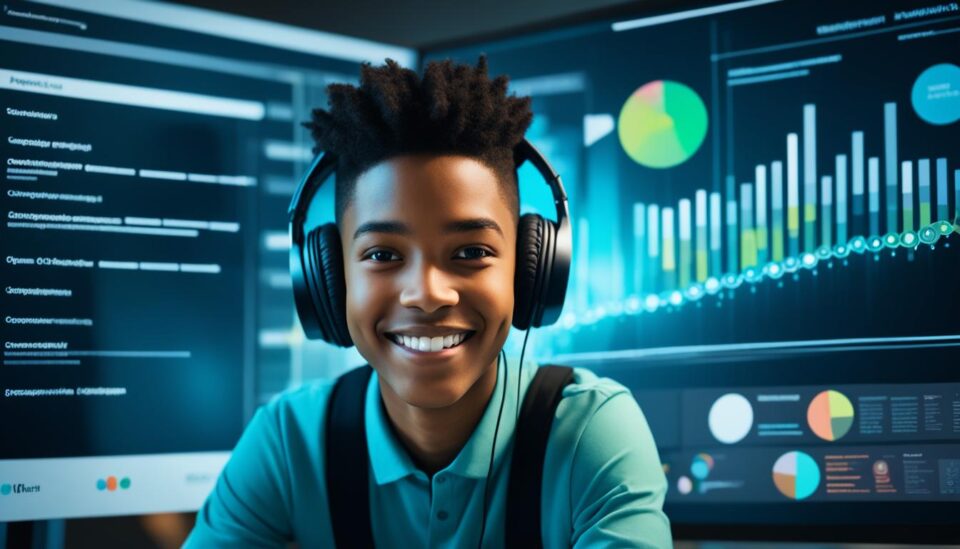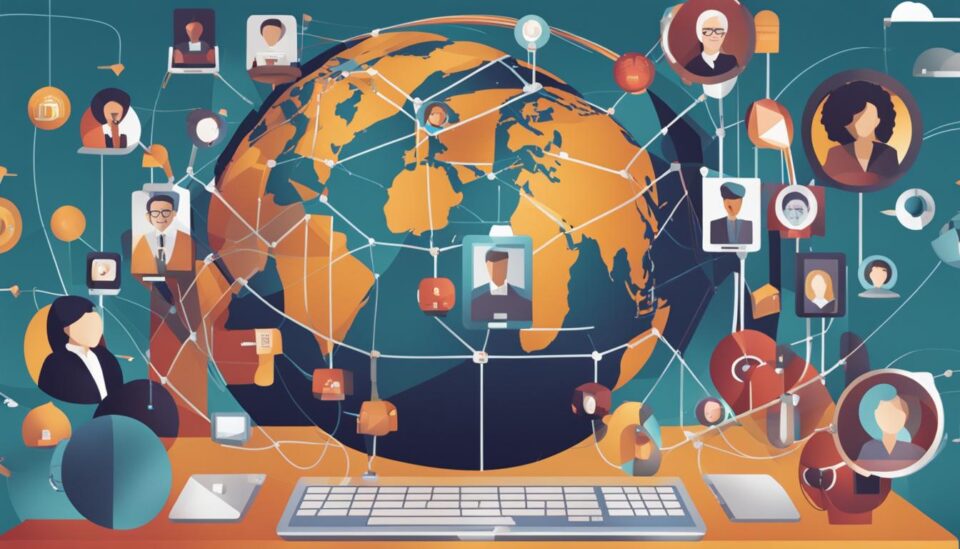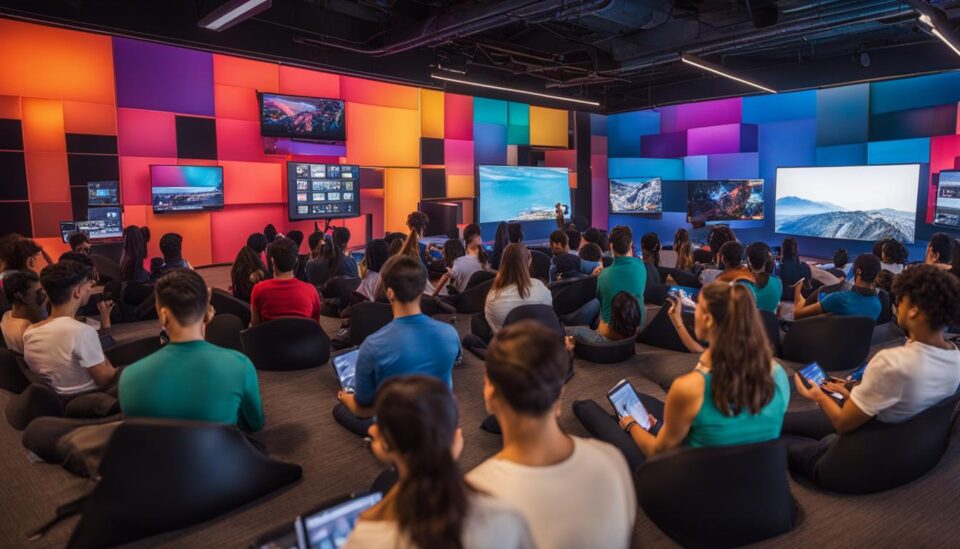E-learning has revolutionized education in the digital age, offering numerous benefits for learners and professionals alike. Online education platforms and virtual learning tools have transformed the way we learn, providing flexibility, accessibility, and personalized learning experiences. Let’s delve into the various advantages of e-learning and how it contributes to career growth and development.
Key Takeaways:
- E-learning provides flexibility and accessibility, allowing learners to study at their own pace and convenience.
- Personalized learning experiences in e-learning cater to individual needs and preferences, enhancing engagement and knowledge retention.
- E-learning is cost-effective, eliminating expenses such as textbooks, commuting, and accommodation.
- Global learning communities in e-learning promote cultural exchange and the development of global citizenship skills.
- E-learning enables lifelong learning and professional development, keeping individuals competitive in a rapidly evolving job market.
Flexibility and Accessibility

E-learning offers learners the unparalleled flexibility and accessibility to access educational content at their convenience, from any location and at any time. Unlike traditional education, which often comes with rigid structures and fixed class schedules, e-learning allows individuals to balance their work or family responsibilities while pursuing their education.
With e-learning, learners have the freedom to design their own learning schedule, allowing them to learn at their own pace and on their own terms. This flexibility makes e-learning an ideal choice for working professionals and individuals with busy schedules, as they can fit their studies around their other commitments.
Online education platforms play a crucial role in enabling flexibility and accessibility in e-learning. These platforms provide a wide range of courses and resources that can be accessed anytime, anywhere, as long as there is an internet connection. Learners have the convenience of accessing lectures, assignments, and study materials from the comfort of their own homes or while on the go.
Whether it’s early in the morning, during lunch breaks, or late at night, learners have the flexibility to choose when and where they want to learn. This flexibility empowers students to take control of their education, optimizing their learning experience and ensuring that it aligns with their unique schedules and preferences.
Personalized Learning Experience

E-learning platforms offer a personalized learning experience that caters to the unique needs and preferences of individual learners. Through the utilization of virtual learning tools and adaptive learning technologies, e-learning platforms can assess learners’ strengths and weaknesses, providing targeted content and recommendations. This personalized approach significantly enhances the learning experience, resulting in improved knowledge retention and maximizing each learner’s potential.
With personalized learning, learners have the freedom to customize their education to match their specific requirements. They can choose the pace at which they progress through the material, delve deeper into topics of interest, or revisit challenging concepts when needed. This level of customization creates a more engaging and effective learning experience, empowering learners to take ownership of their education.
Adaptive learning technologies play a crucial role in delivering personalized experiences in e-learning. These technologies analyze learners’ performance and adapt the content and assessments accordingly. By identifying areas of strength and weakness, the platform can provide targeted interventions, reinforcing concepts that need additional practice or offering more challenging material for advanced learners.
The integration of virtual learning tools further enhances the personalized learning experience. These tools allow learners to engage with the content in interactive and immersive ways. For example, virtual simulations provide hands-on experiences in complex subject areas, helping learners develop practical skills and deep understanding. Visuals, videos, and interactive quizzes make the learning process more enjoyable, increasing engagement and overall retention.
Overall, personalized learning experiences offered by e-learning platforms empower learners to create their educational journey, ultimately leading to a more fulfilling and effective learning experience.
Cost-Effectiveness
One of the significant advantages of e-learning is its cost-effectiveness compared to traditional education. Online courses and educational platforms provide a more affordable alternative, eliminating expenses such as tuition fees, textbooks, transportation, and accommodation. Learners can save money on commuting expenses by accessing educational content from the comfort of their own homes. Additionally, online education platforms often offer digital resources that are available free of charge, reducing the need for costly physical materials.
This cost-effectiveness not only benefits learners but also promotes educational accessibility. E-learning bridges the gap for individuals from diverse socioeconomic backgrounds, allowing them to access quality education at a fraction of the cost. By offering a more affordable option, e-learning fosters equal opportunities for all, regardless of financial constraints.
Global Learning Communities

E-learning has revolutionized education by breaking down geographical barriers and creating global learning communities. Through online education platforms, learners can connect with educators and peers from around the world, enriching their learning experience in profound ways.
This global perspective exposes students to diverse cultures, ideas, and perspectives. By interacting with individuals from different backgrounds, learners gain a broader understanding of the world and develop a global mindset. It fosters empathy, cultural awareness, and the ability to collaborate across borders.
Collaborative online forums, discussion boards, and virtual classrooms play a vital role in cultivating a sense of community among e-learners. These platforms provide spaces for meaningful discussions, knowledge exchange, and networking opportunities. Students can engage in stimulating conversations, learn from their peers’ experiences, and engage in collaborative projects across continents.
By fostering global learning communities, e-learning prepares learners for an interconnected world. It equips them with the skills to communicate effectively in a global context, navigate cultural differences, and work collaboratively with individuals from diverse backgrounds. This exposure to global perspectives enhances critical thinking, creativity, and problem-solving abilities, empowering learners to thrive in a rapidly changing global landscape.
Image: A visualization of global connectivity symbolizing the power of e-learning in forming global learning communities.
Lifelong Learning and Professional Development

In today’s rapidly evolving job market, continuous learning and upskilling are crucial for professional growth and competitiveness. E-learning offers a wide array of courses and certifications that enable individuals to acquire new skills or upgrade existing ones. Professionals can engage in online training programs, webinars, and virtual conferences to stay abreast of the latest industry trends and developments. The convenience and accessibility of e-learning make it an ideal platform for lifelong learning, allowing individuals to adapt to changing job requirements and maintain their competitiveness in their respective fields.
Interactive and Engaging Content

E-learning has revolutionized the way we learn by offering interactive and engaging content that goes beyond traditional classroom lectures and textbooks. Through the use of multimedia tools, simulations, gamification, and interactive content, e-learning captivates learners’ attention and enhances their overall learning experience.
Visuals, such as infographics and diagrams, help to simplify complex concepts and make them more accessible. Videos provide dynamic presentations and demonstrations, allowing learners to visualize real-life scenarios and applications. These visual elements aid in better comprehension and knowledge retention.
Interactive quizzes and activities add an element of enjoyment to the learning process. Learners can actively participate and test their understanding of the content, reinforcing their knowledge and skills. Immediate feedback mechanisms incorporated in e-learning platforms allow learners to assess their progress and identify areas for improvement, fostering a sense of achievement and motivation.
Simulations and Virtual Reality
E-learning platforms often leverage simulations and virtual reality technologies to provide immersive learning experiences. Learners can engage in simulated real-world scenarios, allowing them to practice and apply theoretical knowledge in a safe and controlled environment. This hands-on approach enhances critical thinking, problem-solving, and decision-making skills.
The interactive and engaging nature of e-learning not only makes the learning process more enjoyable but also encourages active participation and deepens understanding. Learners are actively involved in their learning journey, which leads to better knowledge retention and practical application of skills.
Data-Driven Insights

One of the significant advantages of e-learning is the availability of data-driven insights. Online education platforms capture vast amounts of data on learner behavior, performance, and engagement. This data can be used to extract valuable insights that enhance the learning experience and optimize instructional strategies.
By analyzing the data collected from learners, educators can gain a deeper understanding of their strengths, weaknesses, and learning patterns. This enables targeted interventions and personalized support, ensuring that learners receive the assistance they need to succeed.
Through continuous data analysis, e-learning platforms evolve and adapt to the needs of learners. This allows for the creation of more effective educational experiences that cater to individual preferences and learning styles.
Data-driven insights in e-learning enable educators to identify areas of improvement, refine instructional techniques, and make data-informed decisions. By leveraging these insights, e-learning platforms can deliver personalized and impactful education, ultimately enhancing the overall learning outcomes for students.
Flexibility and Convenience in Universities

E-learning in universities offers students the flexibility and convenience to study at their own pace and from any location. With the use of online education platforms, students can access their course materials and lectures whenever and wherever they choose. This flexibility eliminates the need for physical attendance in classrooms, allowing students to fit their studies around their busy schedules or other responsibilities they may have.
Online education platforms also provide mobile compatibility, enabling students to learn using their smartphones or tablets. This means that whether they are on their daily commute or sitting at a coffee shop, students have the convenience of accessing their coursework without the need for a desktop computer.
This flexibility and convenience provided by e-learning in universities not only caters to the needs of working professionals who are juggling their studies with their careers but also allows universities to reach a wider audience. Students from different cities or countries can now pursue higher education from esteemed institutions without having to relocate, increasing access to education for a diverse range of individuals.
Affordability

E-learning in universities offers a cost-effective alternative to traditional in-person education. By eliminating or reducing costs associated with physical infrastructure, such as classrooms, desks, and chairs, e-learning platforms can provide more affordable educational options for students. Online learners also save on expenses like on-campus housing and meal plans, as they have the flexibility to learn from any location. Additionally, the availability of digital textbooks and resources further reduces costs for online students. E-learning platforms provide an affordable solution, making quality education more accessible and inclusive for students from diverse backgrounds.
Enhanced Access and Reach

One of the key benefits of e-learning in universities is the enhanced access and reach it offers to students. Through online education platforms, students can access course materials and lectures from anywhere, at any time. This means that physical presence in the classroom is no longer a requirement for learning. Students have the freedom to study at their own pace and convenience, allowing for a more personalized learning experience.
Furthermore, e-learning enables universities to reach a broader audience beyond their campus boundaries. Students from different cities or countries can now enroll in courses offered by universities located miles away. This increased access to education promotes diversity and cultural exchange, enriching the educational experience for all students.
Global Learning Community
This enhanced access and reach also foster the development of a global learning community. Students from different backgrounds and cultures come together in virtual classrooms, creating a rich and diverse learning environment. Collaborative online forums and discussion boards enable students to engage in meaningful discussions and knowledge-sharing, regardless of their physical location. This global perspective prepares students to thrive in an interconnected world and broadens their perspectives.
Personalized Learning Experience in Universities

E-learning in universities offers a personalized learning experience that caters to the unique needs and preferences of individual students. Through online education platforms, universities have the ability to customize their curriculum and learning materials to suit each student’s specific requirements and learning style. This personalized approach fosters student engagement, comprehension, and knowledge retention, resulting in a more effective and impactful learning experience.
With e-learning, students have the opportunity to explore topics of interest and engage in activities that align with their individual academic goals. They can delve deeper into subjects that captivate their interest and apply their learnings to real-world scenarios. This personalized learning pathway enables students to develop a thorough understanding of the material and gain practical skills that are relevant to their future careers.
E-learning platforms and virtual learning tools play a pivotal role in delivering this personalized learning experience. These platforms utilize adaptive learning technologies, data analysis, and student feedback mechanisms to gauge individual progress and provide targeted recommendations for improvement. The integration of virtual learning tools such as simulations, interactive quizzes, and multimedia content further enhances the personalized learning experience, making it more engaging and interactive.
The benefits of a personalized learning experience in universities are manifold. It caters to the diverse learning needs of students, allowing them to thrive and reach their full potential. By tailoring the curriculum and learning resources, universities can ensure that students receive the most relevant and effective education. This personalized approach also promotes independent thinking, problem-solving skills, and critical analysis among students, equipping them with the necessary tools for lifelong learning and success in their chosen fields.
Enhanced Collaboration and Communication in Universities

E-learning in universities brings about a significant improvement in collaboration and communication among students and instructors. Online education platforms provide a range of tools and features that foster meaningful interactions, irrespective of physical distance.
Through the use of discussion boards, students can engage in vibrant discussions, ask questions, and share their perspectives in a comfortable online environment. This inclusive approach promotes active participation, ensuring that every student’s voice is heard and valued.
Furthermore, e-learning platforms offer video conferencing and instant messaging capabilities that enable real-time communication. Students can collaborate on group projects, seek clarification, and receive immediate feedback from instructors, regardless of their physical location. This seamless communication enhances the learning experience and facilitates a sense of community and engagement.
E-learning platforms also serve as centralized spaces for resource sharing, assignment submission, and feedback. Students can easily access and share relevant materials, submit assignments digitally, and receive timely feedback from instructors. This streamlined communication process improves efficiency and convenience for both students and instructors.
Enhanced collaboration and communication in universities is a key benefit of e-learning. Online education platforms empower students to engage in meaningful discussions, collaborate effortlessly, and receive timely feedback, regardless of physical distance.
With e-learning, universities can foster an environment that encourages open dialogue, knowledge sharing, and collaboration among students and instructors. By removing geographical barriers and promoting effective communication, e-learning creates a robust and inclusive learning community.
Continue reading the article to discover more benefits of e-learning in universities.
Integration of Multimedia and Interactive Learning in Universities

E-learning in universities takes education to a whole new level by integrating multimedia tools and interactive learning experiences. Through the use of videos, podcasts, and online simulations, students can immerse themselves in a dynamic learning environment that enhances their understanding and engagement.
The integration of multimedia content allows students to visualize complex concepts, making them more accessible and understandable. Whether it’s watching a video demonstration, listening to a podcast discussion, or participating in virtual simulations, students have the opportunity to explore different perspectives and gain a comprehensive education.
Furthermore, interactive learning activities foster collaboration and relationship-building among students. With virtual platforms and tools, students can engage in discussions, work on group projects, and exchange ideas. This promotes critical thinking, enhances communication skills, and prepares students for real-world problem-solving scenarios.
An example of an interactive learning tool that universities can incorporate is virtual lab simulations. These simulations replicate real-life laboratory experiments, enabling students to gain practical experience and develop hands-on skills in a virtual environment. By allowing students to manipulate variables and observe outcomes, virtual lab simulations provide a safe and accessible way to learn and experiment.
With the integration of multimedia tools and interactive learning experiences, e-learning in universities not only provides students with a rich and engaging educational experience but also equips them with the practical skills necessary for their future careers.
“The use of multimedia and interactive learning in universities revolutionizes the way students engage with content. It goes beyond traditional lectures and textbooks, allowing students to actively participate in their learning journey.” – Dr. Sarah Johnson, Professor of Education, ABC University
Exposure to Technological Skills in Universities
E-learning in universities provides students with valuable exposure to the technological skills necessary to thrive in the digital age. Through online education platforms, students have the opportunity to gain hands-on experience in using learning management systems, conducting online research, and utilizing professional communication tools.
In today’s job market, being comfortable with technology and remote work is crucial. E-learning equips students with the necessary skills to succeed in a digitally-driven world and prepares them for future careers. By embracing e-learning, universities can foster a tech-savvy environment that encourages innovation and creativity.
By utilizing online education platforms, universities can empower students to explore and master a wide range of technological skills. This exposure not only enhances their ability to navigate digital tools but also instills confidence in their technical prowess. Students who engage in e-learning become adept at using various technological resources, gaining a competitive edge in the job market.
Furthermore, e-learning promotes critical thinking and problem-solving skills, as students learn to adapt to new technologies and leverage them for their educational and professional needs. The exposure to technological skills through e-learning prepares students for the ever-evolving technological landscape, enabling them to contribute innovatively to their fields and make a positive impact in the digital realm.
FAQ
What are the benefits of e-learning?
E-learning offers flexibility, accessibility, personalized learning experiences, cost-effectiveness, global reach, and the opportunity for career growth.
How does e-learning provide flexibility and accessibility?
E-learning allows learners to access educational content at their own convenience, from any location and at any time. Online education platforms offer a wide range of courses that can be accessed anytime, anywhere, providing flexibility and convenience.
What is a personalized learning experience in e-learning?
E-learning platforms provide personalized learning experiences tailored to the unique needs and preferences of individual learners. By leveraging virtual learning tools and adaptive learning technologies, e-learning can assess learners’ strengths and weaknesses, providing targeted content and recommendations.
How is e-learning cost-effective compared to traditional education?
E-learning eliminates expenses such as tuition fees, textbooks, transportation, and accommodation. Learners can save money on commuting expenses and can access digital resources that are often available free of charge.
How does e-learning promote global learning communities?
E-learning transcends geographical boundaries and enables learners to connect with educators and peers from around the world. Collaborative online forums, discussion boards, and virtual classrooms cultivate a sense of community, enabling learners to engage in meaningful discussions, exchange knowledge, and build networks.
How does e-learning support lifelong learning and professional development?
E-learning offers a wide array of courses and certifications that enable individuals to acquire new skills or upgrade existing ones. Professionals can engage in online training programs, webinars, and virtual conferences to stay abreast of the latest industry trends and developments.
How does e-learning provide interactive and engaging content?
E-learning goes beyond classroom lectures by utilizing multimedia tools, simulations, gamification, and interactive content. This approach captivates learners’ attention and facilitates better comprehension and knowledge retention.
What are the data-driven insights that e-learning offers?
E-learning platforms capture vast amounts of data on learner behavior, performance, and engagement. These insights can be used to enhance the learning experience and optimize instructional strategies.
How does e-learning provide flexibility and convenience in universities?
E-learning in universities allows students to study at their own pace and from any location. Online education platforms provide mobile compatibility, allowing students to learn using their smartphones or tablets.
How is e-learning more affordable in universities?
E-learning in universities eliminates or reduces costs associated with physical infrastructure like classrooms, desks, and chairs. Online learners save on expenses like on-campus housing and meal plans. Additionally, online students can save money on textbooks, especially when digital versions are available.
How does e-learning enhance access and reach in universities?
E-learning in universities allows students to access course materials and lectures from anywhere at any time. This enhanced access eliminates the need for physical presence in the classroom and accommodates students with busy schedules or other responsibilities.
What is a personalized learning experience in universities?
E-learning in universities provides a personalized learning experience tailored to individual student needs and preferences. Universities can customize their curriculum to suit the unique requirements and learning styles of each student.
How does e-learning promote collaboration and communication in universities?
E-learning in universities facilitates meaningful interactions through discussion boards, video conferencing, and instant messaging. Students can engage in discussions and ask questions in a comfortable online environment, promoting inclusivity and active participation.
How does e-learning integrate multimedia and interactive learning in universities?
E-learning in universities utilizes multimedia tools, such as videos, podcasts, and online simulations, to enhance the learning experience. Students can engage in interactive activities, discussions, and group projects, fostering collaboration and relationship-building.
What technological skills can students gain through e-learning in universities?
E-learning in universities exposes students to technology skills necessary in the digital age. Students gain experience in using learning management systems, online research, and professional communication tools.
 Sharing is Caring Blog Something different…
Sharing is Caring Blog Something different…









